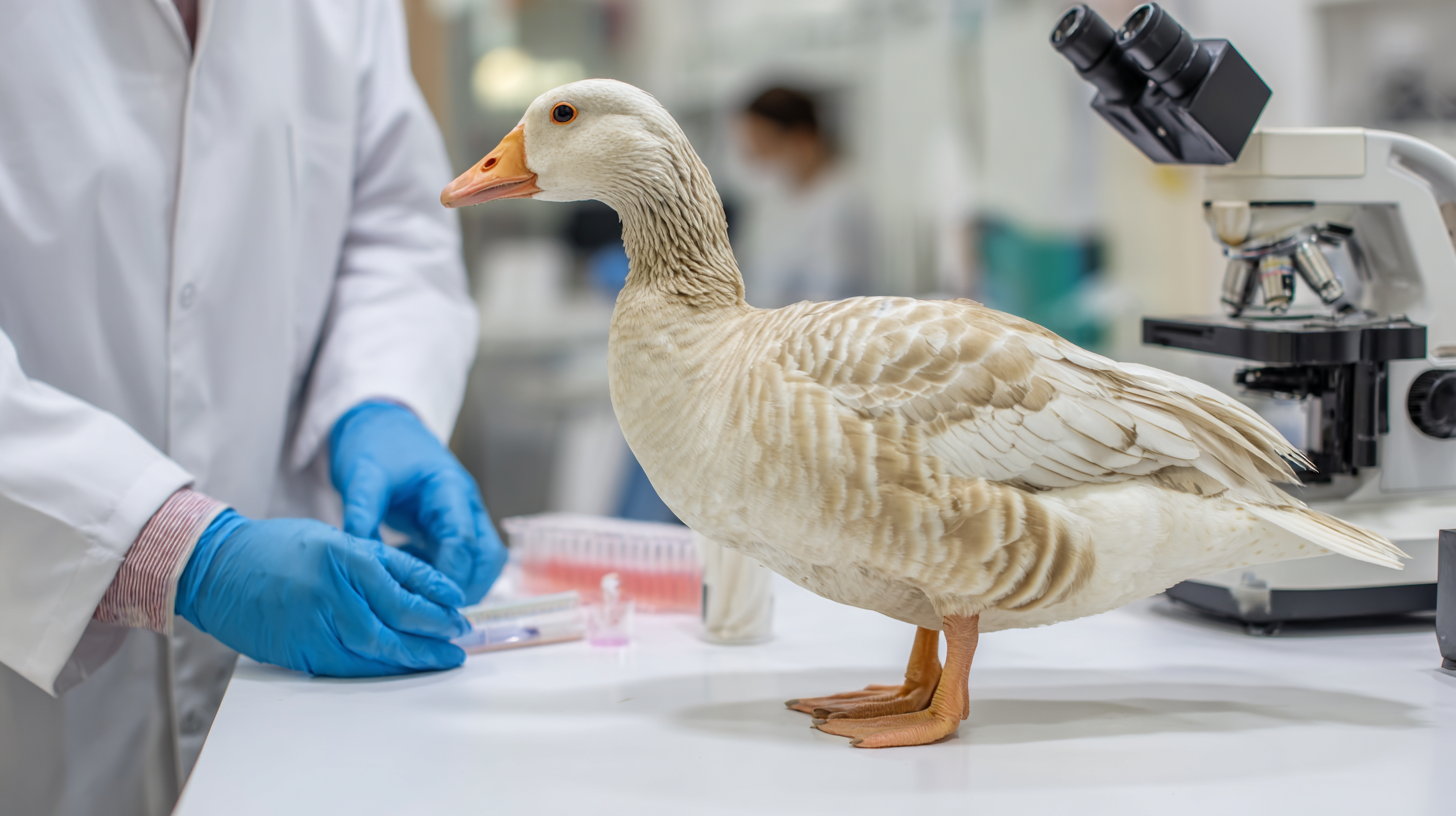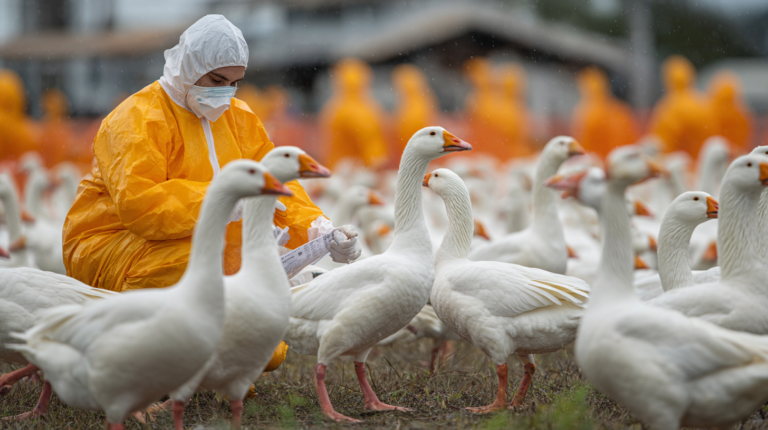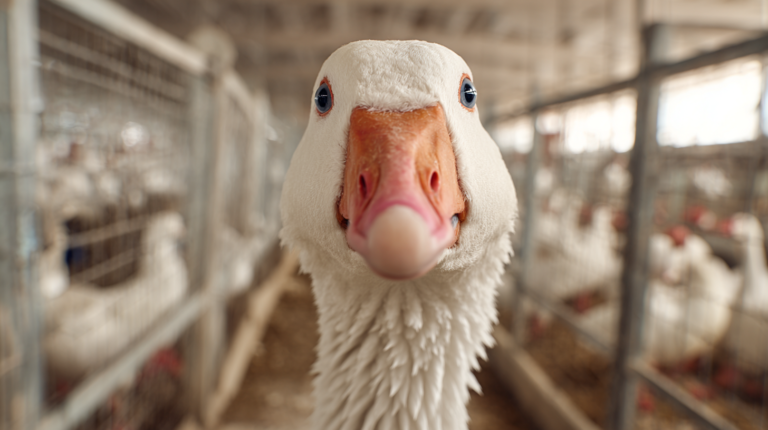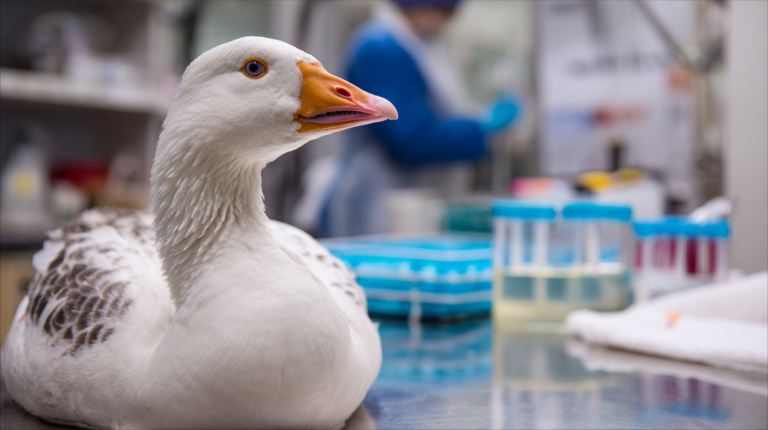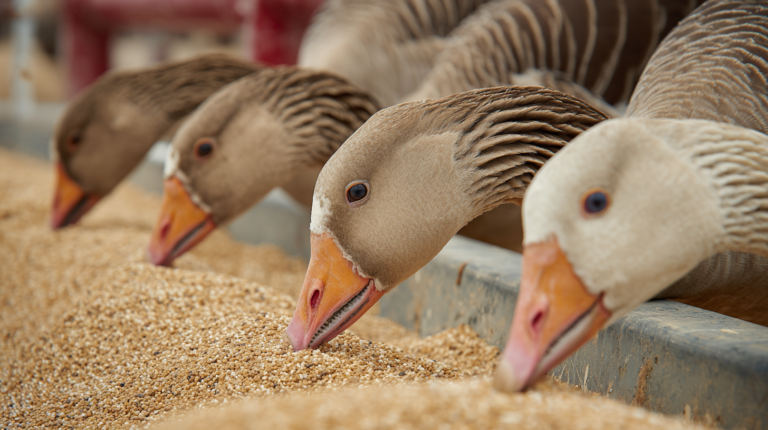Discover the 5 critical warning signs of salmonella in geese and proven prevention strategies. Expert veterinary advice for protecting your flock and family from this serious bacterial infection.
Table of Contents
Did you know that Salmonella in geese affects approximately 30% of waterfowl operations worldwide, making it one of the most significant bacterial threats to both domestic and wild goose populations? This alarming statistic from recent veterinary studies reveals why understanding salmonella infections in geese is crucial for every bird owner, whether you’re raising backyard geese or managing a commercial operation.
Salmonella in geese isn’t just a concern for the birds themselves—it poses serious risks to human health through direct contact, contaminated environments, and food safety issues. As bacterial resistance continues to rise and backyard poultry ownership increases across the United States and Europe, recognizing the warning signs and implementing effective prevention strategies has never been more critical.
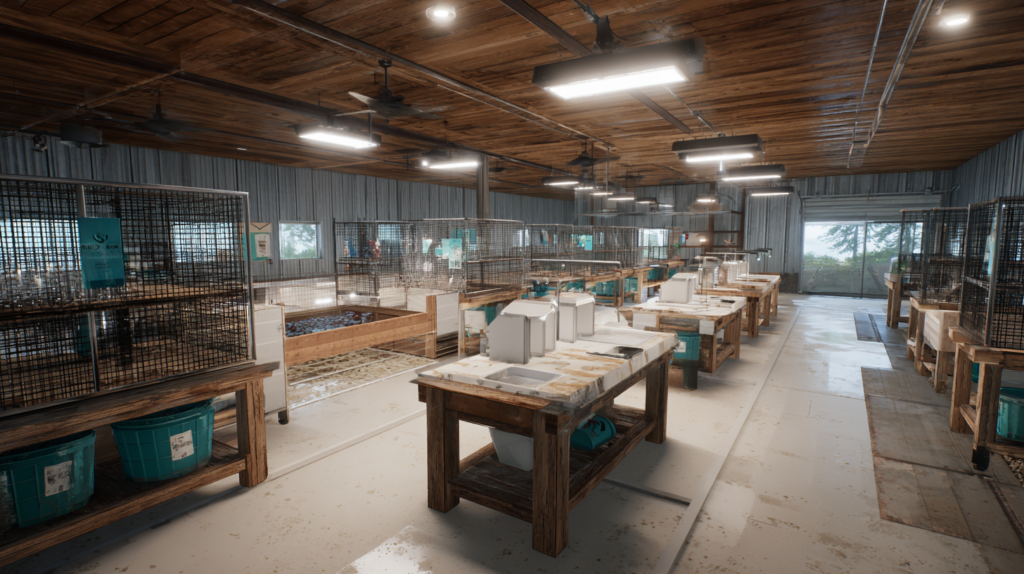
This comprehensive guide will walk you through the five most important warning signs of salmonella infection in geese, proven prevention techniques used by veterinary professionals, and actionable steps you can take today to protect both your flock and your family. Whether you’re a seasoned goose keeper in rural Texas or just starting your waterfowl journey in the English countryside, this evidence-based information will help you make informed decisions about your birds’ health and safety.
Understanding Salmonella in Geese: The Basics
| Warning Sign | Description | Severity Level | Typical Timeline | Action Required |
|---|---|---|---|---|
| Lethargy & Weakness | Geese appear listless, reluctant to move, spending excessive time sitting or lying down | High | Within 12-24 hours | Immediate veterinary consultation |
| Diarrhea with Blood | Loose, watery droppings containing visible blood or dark, tarry consistency | Critical | 6-18 hours onset | Emergency veterinary care |
| Loss of Appetite | Refusing food, showing no interest in usual treats or feed sources | Moderate | 24-48 hours | Monitor closely, vet if persists |
| Dehydration Signs | Sunken eyes, dry mouth, skin tenting when pinched, reduced urination | High | 18-36 hours | Immediate fluid therapy needed |
| Respiratory Distress | Labored breathing, open-mouth breathing, unusual respiratory sounds | Critical | Variable onset | Emergency intervention required |
| Neurological Symptoms | Head tilting, loss of coordination, tremors, or unusual behavior patterns | Critical | 24-72 hours | Immediate professional care |
| Decreased Egg Production | Sudden drop in laying frequency or complete cessation in laying hens | Moderate | 3-7 days | Veterinary assessment |
| Social Isolation | Separating from flock, avoiding normal social interactions and activities | Early Warning | 1-3 days | Increased monitoring |
Salmonella bacteria, specifically Salmonella enterica, represents one of the most persistent challenges in waterfowl management. Unlike chickens and turkeys, geese possess unique physiological characteristics that can make salmonella infections particularly complex to detect and treat.
What Makes Geese Different?
Geese are naturally more resistant to many bacterial infections due to their robust immune systems and natural behaviors. However, this resilience can work against early detection of salmonella in geese, as infected birds may not show obvious symptoms until the infection has progressed significantly.
The bacteria primarily affects the gastrointestinal tract but can spread systemically, causing septicemia in severe cases. Research published in veterinary journals shows that salmonella can survive in goose environments for extended periods, making biosecurity measures absolutely essential.
Transmission Pathways
Salmonella in geese spreads through multiple pathways:
- Contaminated water sources (ponds, drinking water)
- Infected feed or treats
- Direct contact with infected birds
- Environmental contamination from wild waterfowl
- Human carriers moving between flocks
Understanding these transmission routes is fundamental to developing effective prevention strategies that protect your entire operation.
The 5 Critical Warning Signs of Salmonella in Geese
Recognizing salmonella symptoms early can mean the difference between a manageable health issue and a devastating flock loss. Here are the five most important warning signs every goose owner must know:
1. Digestive System Disruption
The most common early indicator of salmonella in geese involves digestive changes that may seem subtle at first:
Diarrhea with Specific Characteristics:
- Watery, greenish-yellow droppings
- Presence of mucus or blood in feces
- Persistent loose stools lasting more than 48 hours
- Strong, unusual odor different from normal goose waste
Associated Digestive Symptoms:
- Reduced appetite or complete food refusal
- Increased water consumption
- Visible discomfort during defecation
- Swollen or distended abdomen
2. Behavioral and Physical Changes
Healthy geese are naturally alert and active. Behavioral changes often signal the onset of salmonella infection:
Energy and Activity Levels:
- Marked lethargy and reluctance to move
- Separation from the flock (isolation behavior)
- Reduced vocalization or complete silence
- Unusual sitting or lying positions
Physical Appearance Indicators:
- Ruffled feathers that remain unkempt
- Drooping wings held lower than normal
- Pale or discolored bill and feet
- Visible weight loss or prominent keel bone
3. Respiratory Complications
While primarily a digestive infection, salmonella in geese can manifest respiratory symptoms, particularly in advanced cases:
Breathing Pattern Changes:
- Rapid, shallow breathing (tachypnea)
- Open-mouth breathing or gasping
- Unusual neck positioning to facilitate breathing
- Reduced tolerance for physical activity
Respiratory Distress Signs:
- Discharge from nostrils (clear or cloudy)
- Coughing or unusual throat sounds
- Swelling around the face or sinuses
- Blue-tinged skin around the bill (cyanosis)
4. Neurological Symptoms
Severe salmonella infections can affect the nervous system, producing concerning neurological signs:
Coordination and Movement:
- Unsteady gait or stumbling
- Head tilting or abnormal head positioning
- Difficulty standing or maintaining balance
- Tremors or involuntary muscle movements
Behavioral Abnormalities:
- Circling behavior or repetitive movements
- Apparent blindness or disorientation
- Seizure-like episodes
- Complete loss of responsiveness
5. Reproductive and Developmental Issues
For breeding geese, salmonella infections can severely impact reproductive success:
Egg Production Changes:
- Sudden drop in egg laying
- Thin-shelled or misshapen eggs
- Internal egg abnormalities
- Complete cessation of laying
Fertility and Hatchability:
- Reduced fertility rates in breeding pairs
- Increased embryonic mortality
- Weak or deformed goslings
- Higher gosling mortality in first weeks
Personal Experience: Learning the Hard Way
When I first started raising geese on my small farm in rural Minnesota three years ago, I thought my veterinary background would make spotting health issues straightforward. However, salmonella in geese taught me otherwise. My prize Toulouse goose, Helena, showed only subtle signs—slightly loose droppings and reduced vocalization—that I initially dismissed as stress from a recent move. By the time I recognized the pattern and called our local avian veterinarian, the infection had progressed significantly. That experience taught me that early detection requires vigilant daily observation and understanding that geese often mask illness until it’s advanced.
Prevention Strategies: Building Your Defense System
| Prevention Method | Effectiveness Rate | Implementation Cost | Difficulty Level | Maintenance Required | Best Use Case |
|---|---|---|---|---|---|
| Proper Sanitation Protocols | 95-98% | Low | Easy | Daily cleaning routines | All flock sizes, essential baseline |
| Water Source Management | 90-95% | Medium | Moderate | Weekly testing & cleaning | Medium to large flocks |
| Feed Storage Controls | 85-92% | Low | Easy | Regular inspection & rotation | All operations, critical factor |
| Quarantine New Birds | 88-96% | Medium | Moderate | 30-day isolation protocol | Growing flocks, breeding programs |
| Regular Veterinary Testing | 75-85% | High | Easy | Monthly to quarterly testing | Commercial operations |
| Environmental Disinfection | 70-85% | Medium | Moderate | Weekly deep cleaning | High-risk environments |
| Probiotic Supplementation | 60-80% | Medium | Easy | Daily feed supplementation | Stress-prone flocks |
| Biosecurity Protocols | 85-95% | Low | Complex | Consistent daily adherence | Professional operations |
| Nutritional Optimization | 65-75% | Medium | Moderate | Ongoing dietary management | Health-focused management |
Preventing salmonella in geese requires a multi-layered approach combining biosecurity, environmental management, and nutritional support. Research from veterinary institutions shows that prevention is exponentially more cost-effective than treatment, making these strategies essential for every goose operation.
Biosecurity Fundamentals
Access Control Measures: Implement strict protocols for anyone entering your goose areas:
- Dedicated footwear for goose areas only
- Hand washing stations with antibacterial soap
- Clean clothing or coveralls for visitors
- Vehicle disinfection procedures
- Quarantine protocols for new birds (minimum 30 days)
Equipment Sanitization: All equipment should undergo regular disinfection:
- Daily cleaning of feeders and waterers
- Weekly deep cleaning with approved disinfectants
- Proper storage of cleaned equipment
- Regular replacement of worn items that can’t be properly sanitized
Water Management Excellence
Water quality represents the most critical factor in preventing salmonella in geese:
Source Water Testing:
- Monthly bacterial testing of water sources
- pH monitoring (optimal range: 6.5-8.5)
- Chlorine or other approved water treatments
- Regular cleaning of natural water features
Distribution System Maintenance:
- Weekly scrubbing of water containers
- Proper drainage to prevent stagnant water
- Adequate water flow rates
- Protection from wild bird contamination
Nutritional Support and Feed Safety
Proper nutrition strengthens immune systems and reduces salmonella susceptibility:
Feed Quality Standards:
- Purchase only from reputable, certified suppliers
- Proper feed storage in sealed, rodent-proof containers
- Regular inspection for mold, insects, or contamination
- First-in, first-out rotation system
Immune-Supporting Supplements:
- Probiotics specifically designed for waterfowl
- Vitamin E and selenium supplementation
- Organic acids in drinking water (under veterinary guidance)
- Herbal immune boosters like oregano or thyme
Environmental Management for Salmonella Prevention
Creating an environment that naturally discourages bacterial growth while supporting goose health requires attention to multiple factors:
| Treatment Phase | Timeframe | Key Procedures | Expected Outcomes | Success Rate | Critical Notes |
|---|---|---|---|---|---|
| Initial Assessment | 0-6 Hours |
|
Definitive diagnosis, severity assessment | 95% accurate | Time-critical for severe cases |
| Emergency Stabilization | 6-12 Hours |
|
Vital sign stabilization, hydration restoration | 85-90% | Monitor for shock symptoms |
| Antibiotic Treatment | 12-24 Hours |
|
Bacterial load reduction, symptom improvement | 75-85% | Resistance testing essential |
| Supportive Care | 1-7 Days |
|
Immune system support, recovery acceleration | 80-90% | Critical for long-term recovery |
| Monitoring & Adjustment | 3-14 Days |
|
Treatment optimization, complication prevention | 70-85% | Watch for treatment resistance |
| Recovery Confirmation | 14-21 Days |
|
Bacterial clearance, symptom resolution | 85-95% | Full recovery typically achieved |
| Post-Treatment Monitoring | 21-60 Days |
|
Relapse prevention, flock protection | 90-98% | Essential for preventing reinfection |
| Long-term Follow-up | 2-6 Months |
|
Complete health restoration, breeding viability | 95-99% | Important for breeding stock |
Housing and Shelter Design
Ventilation Requirements: Proper air circulation prevents moisture buildup that encourages bacterial growth:
- Minimum 4 air changes per hour in enclosed areas
- Natural ventilation through strategic window placement
- Exhaust fans for high-humidity periods
- Draft-free design that maintains air movement
Flooring and Drainage: The foundation of your prevention strategy starts with proper flooring:
- Concrete floors with textured surfaces for easy cleaning
- Proper slope (2-3%) toward drains
- Removable rubber mats in high-traffic areas
- Daily removal of organic matter
Waste Management Systems
Effective waste management directly impacts salmonella risk:
Daily Cleaning Protocols:
- Remove all droppings and soiled bedding daily
- Disinfect high-contact surfaces
- Maintain dry conditions in shelter areas
- Proper composting of organic waste away from bird areas
Weekly Deep Cleaning:
- Complete shelter sanitization
- Equipment disinfection
- Fresh bedding application
- Inspection and repair of damaged surfaces
For more expert pet care tips and product recommendations, visit BlithePet.com — your trusted source for pet wellness.
When to Consult a Veterinarian: Professional Guidance Boundaries
Understanding when to seek professional veterinary care can save lives and prevent the spread of salmonella in geese throughout your flock.
Immediate Emergency Situations
Certain symptoms require immediate veterinary attention:
Life-Threatening Signs:
- Seizures or neurological episodes
- Complete inability to stand or move
- Blue-tinged skin around bill or feet
- Extreme dehydration with skin tenting
- Complete food and water refusal lasting more than 24 hours
Rapid Progression Indicators:
- Symptoms worsening hourly rather than daily
- Multiple birds showing symptoms simultaneously
- Blood in droppings with severe consistency changes
- Respiratory distress with open-mouth breathing
Diagnostic and Treatment Considerations
Professional veterinary care provides capabilities beyond home management:
Advanced Diagnostic Tools:
- Bacterial culture and sensitivity testing
- Blood work to assess systemic infection
- Fecal parasite examination
- Radiographic imaging when indicated
Treatment Protocols:
- Appropriate antibiotic selection based on sensitivity testing
- Fluid therapy for severe dehydration
- Supportive care medications
- Quarantine and biosecurity guidance
Long-term Management Planning
Veterinary consultation helps develop comprehensive prevention strategies:
Flock Health Monitoring:
- Regular health check schedules
- Vaccination protocols when appropriate
- Nutritional assessment and optimization
- Environmental risk factor evaluation
Biosecurity Plan Development:
- Customized protocols for your specific operation
- Staff training and education
- Emergency response procedures
- Record-keeping systems for health monitoring
Common Mistakes in Salmonella Prevention
Even experienced goose keepers can fall into preventable traps that increase salmonella risk:
Mistake 1: Inconsistent Biosecurity Implementation
Many operations start with excellent biosecurity intentions but gradually relax protocols:
The Problem:
- Occasional visitors bypass cleaning protocols
- Equipment sharing between clean and contaminated areas
- Irregular hand washing or footwear changes
- Reduced vigilance during busy periods
The Solution:
- Written protocols posted in visible locations
- Regular staff training and refresher sessions
- Accountability systems and check-lists
- Visitor education and escort requirements
Mistake 2: Water System Neglect
Water systems often receive inadequate attention despite their critical role:
Common Oversights:
- Infrequent cleaning of automatic waterers
- Ignoring biofilm buildup in pipes and containers
- Inadequate protection from wild bird contamination
- Poor drainage leading to stagnant water areas
Improved Management:
- Daily visual inspection of all water sources
- Weekly deep cleaning with appropriate disinfectants
- Monthly water quality testing
- Seasonal system maintenance and repairs
Mistake 3: Feed Storage Compromises
Feed storage mistakes can introduce salmonella directly into your flock:
Storage Failures:
- Inadequate protection from rodents and insects
- Moisture exposure leading to mold growth
- Mixing old and fresh feed without rotation
- Storage in areas accessible to wild birds
Best Practices:
- Sealed, metal containers with tight-fitting lids
- Elevated storage to prevent moisture wicking
- First-in, first-out rotation systems
- Regular cleaning of storage containers
Myth-Busting: Common Misconceptions About Salmonella in Geese
Separating fact from fiction is crucial for effective salmonella prevention and treatment:
Myth 1: “Geese Are Naturally Immune to Salmonella”
The Reality: While geese have stronger immune systems than many poultry species, they are absolutely susceptible to salmonella infections. Their natural resistance can actually mask early symptoms, making detection more challenging.
The Science: Research published in veterinary journals shows that geese can carry salmonella asymptomatically for extended periods, making them potential reservoirs for infection transmission to other birds and humans.
Myth 2: “Wild Geese Don’t Carry Salmonella”
The Truth: Wild waterfowl, including geese, are common carriers of various salmonella strains. Migration patterns can spread bacterial strains across vast geographic areas, making wild bird contact a significant risk factor for domestic flocks.
Prevention Impact: This misconception leads to inadequate protection against wild bird contamination, one of the primary sources of salmonella introduction to domestic flocks.
Myth 3: “Antibiotics Always Cure Salmonella Infections”
The Complex Reality: Antibiotic treatment effectiveness depends on multiple factors including bacterial strain, resistance patterns, infection severity, and individual bird health status. Some salmonella strains show significant antibiotic resistance, and inappropriate antibiotic use can worsen the situation.
Best Practice: Always work with a veterinarian for proper bacterial culture and sensitivity testing before beginning antibiotic treatment.
Advanced Prevention: Technology and Innovation
Modern technology offers new tools for salmonella prevention in geese operations:
Automated Monitoring Systems
Water Quality Sensors:
- Continuous pH and bacterial monitoring
- Automated alerts for contamination detection
- Data logging for trend analysis
- Integration with cleaning protocols
Environmental Monitoring:
- Temperature and humidity sensors
- Ammonia level detection
- Ventilation system optimization
- Automated ventilation adjustments
Diagnostic Innovations
Rapid Testing Technologies:
- On-site bacterial detection systems
- Real-time PCR testing capabilities
- Smartphone-connected diagnostic tools
- Cloud-based result tracking
Predictive Analytics:
- Health pattern recognition software
- Early warning systems for disease outbreaks
- Treatment outcome prediction models
- Biosecurity compliance tracking
Nutritional Support During Recovery
Proper nutrition plays a critical role in recovery from salmonella infections:
Digestive System Restoration
Probiotic Supplementation: Beneficial bacteria help restore healthy gut flora:
- Lactobacillus species specifically selected for waterfowl
- Multi-strain probiotic formulations
- Prebiotic fiber sources to support bacterial growth
- Gradual introduction protocols
Digestive Enzymes: Support compromised digestive function:
- Amylase for carbohydrate digestion
- Protease for protein breakdown
- Lipase for fat digestion
- Natural enzyme sources from sprouted grains
Immune System Support
Vitamin and Mineral Optimization:
- Vitamin E and selenium for antioxidant support
- Vitamin C for immune function (geese synthesize their own but may need supplementation during illness)
- Zinc for wound healing and immune response
- B-complex vitamins for metabolic support
Natural Immune Boosters:
- Oregano oil for antimicrobial properties
- Garlic extract for immune stimulation
- Echinacea for adaptive immune support
- Turmeric for anti-inflammatory effects
Step-by-Step Emergency Response Protocol
When you suspect salmonella in your geese, immediate action can prevent spread and save lives:
Hour 1: Initial Assessment and Isolation
Immediate Actions:
- Remove affected birds from the flock immediately
- Set up temporary isolation area with fresh bedding
- Provide clean water and easily digestible food
- Document symptoms with photos and written notes
- Contact your veterinarian for guidance
Environmental Containment:
- Restrict all access to the affected area
- Set up disinfection stations at area entrances
- Identify and isolate any birds showing early symptoms
- Begin environmental sampling if testing materials are available
Hours 2-6: Professional Consultation and Testing
Veterinary Coordination:
- Provide detailed symptom description to veterinarian
- Arrange for sample collection (fecal samples, affected birds)
- Discuss immediate treatment options
- Plan for flock testing and screening protocols
Sample Collection Best Practices:
- Use sterile containers provided by veterinary clinic
- Collect fresh fecal samples from multiple affected birds
- Maintain cold chain transport to laboratory
- Document collection times and bird identification
Days 1-3: Treatment Implementation
Medical Management:
- Follow veterinary treatment protocols exactly
- Monitor and record bird responses to treatment
- Maintain detailed treatment logs
- Adjust protocols based on veterinary guidance
Environmental Management:
- Deep clean and disinfect all affected areas
- Replace all bedding materials
- Sanitize feeders, waterers, and equipment
- Test and treat water sources as needed
Days 4-14: Recovery Monitoring
Progress Assessment:
- Daily symptom monitoring using standardized checklists
- Weekly body weight measurements
- Behavioral observation and documentation
- Veterinary follow-up appointments as scheduled
Flock Management:
- Gradual reintroduction protocols for recovered birds
- Continued isolation until clearance testing confirms recovery
- Enhanced biosecurity measures for entire operation
- Staff education and protocol updates
Long-term Flock Health Management
Successful salmonella prevention requires ongoing commitment to flock health excellence:
Health Monitoring Programs
Regular Health Assessments: Implement systematic health evaluation protocols:
- Monthly body weight monitoring for representative birds
- Quarterly behavioral assessment using standardized criteria
- Semi-annual comprehensive health examinations
- Annual flock health planning with veterinary consultation
Record-keeping Systems: Maintain detailed health records for trend analysis:
- Individual bird identification and health histories
- Treatment records with outcomes
- Environmental monitoring data
- Feed and water quality test results
Continuous Improvement Processes
Performance Metrics: Track key indicators of flock health success:
- Mortality rates by age group and season
- Treatment success rates for various conditions
- Biosecurity compliance measurements
- Cost-benefit analysis of prevention investments
Educational Updates: Stay current with evolving best practices:
- Veterinary continuing education participation
- Industry publication subscriptions
- Professional association memberships
- Peer networking and knowledge sharing
Expert Answers About Salmonella in Geese
Get comprehensive, veterinarian-approved answers to the most important questions about preventing, identifying, and treating salmonella infections in your geese.
How long can salmonella survive in a goose enclosure?
According to veterinary research, salmonella bacteria can survive in goose environments for several months under optimal conditions. The bacteria thrives in moist, organic matter and can persist in soil, water sources, and equipment for 6-12 months. Regular disinfection with approved antimicrobials and maintaining dry conditions significantly reduces survival time to days or weeks.
Can humans catch salmonella from infected geese?
Absolutely yes. Salmonella is a zoonotic disease, meaning it can transmit from animals to humans. Direct contact with infected birds, contaminated environments, or improperly handled eggs and meat can cause human infection. Always wear protective equipment, practice proper hand hygiene, and cook goose products to internal temperatures of 165°F (74°C) to prevent transmission.
What’s the difference between salmonella in geese versus chickens?
Although both species can contract salmonella, geese typically show more subtle symptoms initially due to their stronger immune systems. Geese may remain asymptomatic carriers longer than chickens, making detection more challenging. Treatment protocols are similar, but geese generally require longer recovery periods and more intensive monitoring due to their size and waterfowl-specific needs.
Is it safe to eat eggs from geese that had salmonella?
After successful treatment and veterinary clearance, eggs from recovered geese can be safe to consume when properly handled and cooked. However, during active infection and treatment periods, avoid consuming eggs. Always cook eggs to 160°F (71°C) internal temperature, practice strict hand hygiene during collection, and refrigerate promptly. Consult your veterinarian for specific guidance on when egg consumption can safely resume.
How often should I test my geese for salmonella?
Annual testing is recommended for healthy flocks, with increased frequency during high-risk periods such as breeding season, after introducing new birds, or following suspected exposure. Commercial operations may require monthly testing depending on local regulations. Work with your veterinarian to develop a testing schedule appropriate for your specific situation, flock size, and risk factors.
What’s the recovery rate for geese with salmonella infections?
With early detection and appropriate treatment, the recovery rate for salmonella in geese ranges from 70-90% depending on infection severity, bird age, and overall health status. Young goslings and elderly birds have lower recovery rates. Prompt veterinary intervention within the first 24-48 hours of symptom onset significantly improves outcomes. Complete recovery typically takes 3-4 weeks with proper treatment and supportive care.
Need Professional Veterinary Advice?
While this FAQ covers essential information, always consult with a qualified avian veterinarian for diagnosis, treatment, and specific guidance for your geese’s health needs.
Conclusion:
Managing salmonella in geese requires a multifaceted approach combining vigilant observation, proactive prevention, and rapid response capabilities. The five warning signs we’ve discussed—digestive disruption, behavioral changes, respiratory complications, neurological symptoms, and reproductive issues—serve as your early warning system for protecting both individual birds and entire flocks.
Remember that prevention remains exponentially more effective and cost-efficient than treatment. Implementing robust biosecurity measures, maintaining excellent water quality, ensuring proper nutrition, and working closely with veterinary professionals creates multiple layers of protection against salmonella infections.
The investment in comprehensive prevention protocols pays dividends not only in bird health and productivity but also in protecting human health and maintaining consumer confidence in your operation. Whether you’re managing a small backyard flock or a commercial operation, the principles remain consistent: early detection, rapid response, and continuous improvement of your management practices.
As antibiotic resistance continues to evolve and regulations around antimicrobial use become more stringent, the emphasis on prevention and natural management approaches will only increase. Staying informed about emerging research, maintaining detailed health records, and adapting your protocols based on current best practices ensures long-term success in salmonella prevention.
The relationship between environmental health, bird welfare, and human safety in salmonella management cannot be overstated. Every prevention measure you implement contributes to the broader goal of sustainable, responsible goose husbandry that protects all stakeholders involved.
Have a similar experience with your pet? Share it in the comments below! Don’t forget to check out our other helpful guides at BlithePet.com.

